
The First Anglo-Burmese War, also known as the First Burma War in English language accounts and First English Invasion War in Burmese language accounts, was the first of three wars fought between the British and Burmese empires in the 19th century. The war, which began primarily over the control of what is now Northeastern India, ended in a decisive British victory, giving the British total control of Assam, Manipur, Cachar and Jaintia as well as Arakan Province and Tenasserim. The Burmese submitted to a British demand to pay an indemnity of one million pounds sterling, and signed a commercial treaty.

Bagyidaw was the seventh king of the Konbaung dynasty of Burma from 1819 until his abdication in 1837. Prince of Sagaing, as he was commonly known in his day, was selected as crown prince by his grandfather King Bodawpaya in 1808, and became king in 1819 after Bodawpaya's death. Bagyidaw moved the capital from Amarapura back to Ava in 1823.

General Maha Bandula was commander-in-chief of the Royal Burmese Armed Forces from 1821 until his death in 1825 in the First Anglo-Burmese War. Bandula was a key figure in the Konbaung dynasty's policy of expansionism in Manipur and Assam that ultimately resulted in the war and the beginning of the downfall of the dynasty. Nonetheless, the general, who died in action, is celebrated as a national hero by the Burmese for his resistance to the British. Today, some of the most prominent places in the country are named after him.

The Supreme Court of Myanmar is the highest judicial forum and final court of appeal under the Constitution of Myanmar, existing as an independent judicial entity, alongside the legislative and executive branches. The Court is legally mandated to have 7 to 11 judges, including a Chief Justice.
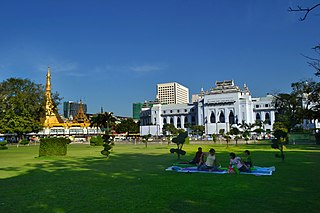
Kyauktada Township is the center of downtown Yangon, Myanmar. The township consists of nine wards, and shares borders with Botataung Township in the east, Seikkan Township and Yangon River in the south, Pabedan Township in the west and Mingala Taungnyunt Township in the north.

Pazundaung Township is a township located in the southeastern part of Yangon, Myanmar. The township consists of ten wards, and shares borders with Botataung Township in the west and the south, Mingala Taungnyunt Township in the northwest, Thaketa Township in the north and the Pazundaung Creek in the east. Pazundaung is connected to Dawbon Township across the Maha Bandula Bridge. The township has nine primary schools, three middle schools and four high schools as well as a hospital. Pazundaung Market and Yegyaw Market are the main shopping bazaars of the area.

Dawbon Township is located in the southeastern part of Yangon, Myanmar. The township comprises 14 wards, and shares borders with Thingangyun township in the north, Mingala Taungnyunt township in the west, Thaketa township in the east, and Pazundaung township in the south across the Pazundaung Creek. Dawbon is connected to downtown Yangon via the Maha Bandula Bridge.

Yangon City Hall is the city hall of Yangon, the largest city of Myanmar, and the seat of the city's administrative body, Yangon City Development Committee (YCDC). The building is considered a fine example of syncretic Burmese architecture, featuring traditional tiered roofs called pyatthat, and was designed by Burmese architect U Tin, who also designed Central Railway Station. Construction began in 1926 and ended in 1936. The city hall occupies the former site of the Ripon Hall.

The Maha Bandula Park or Maha Bandula Garden is a public park, located in downtown Yangon, Burma. The park is bounded by Maha Bandula Garden Street in the east, Sule Pagoda Road in the west, Konthe Road in the south and Maha Bandula Road in the north, and is surrounded by some of the important buildings in the area such as the Sule Pagoda, the Yangon City Hall and the High Court. The park is named after General Maha Bandula who fought against the British in the First Anglo-Burmese War (1824–1826).
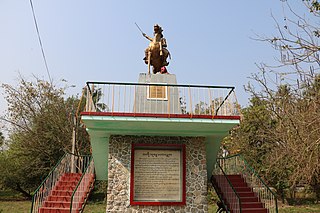
Danubyu Township, also spelt Danuphyu and formerly as Donabyu, is a township of Maubin District in the Ayeyarwady Region of Burma (Myanmar). Danubyu Township is known as the death place of the general Maha Bandula at Danubyu Fort effectively ending the First Anglo-Burmese War by forcing the Burmese to surrender to the British.
Danubyu is a town in the Ayeyarwady Division of south-west Myanmar, located on the west bank of the Ayeyarwady River in the Ayeyarwady Delta. It is the seat of the Danubyu Township in the Maubin District.

The Muslim Free Hospital was established as a small dispensary in 1937 in Yangon, Myanmar and gradually it has come up to the present status of a 160 bedded hospital.
Maha Bandula is a 19th-century Burmese general who fought against the British in the First Anglo-Burmese War of 1824–1826.
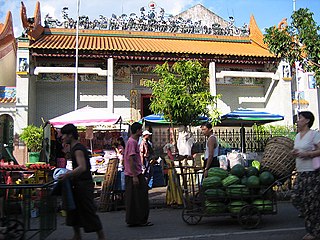
Guanyin Gumiao Temple is one of two major Chinese temples located within Latha Township in Yangon's Chinatown. It was founded by the Cantonese community of Yangon in 1823, but was destroyed by a fire in December 1855, and subsequently rebuilt in 1864, with two additional brick buildings to the side built in 1872. The temple is located on Maha Bandula Road and is dedicated to Guanyin, a Buddhist bodhisattva corresponding to the Burmese Buddhist bodhisattva Avalokiteśvara.
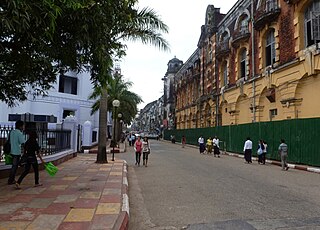
Maha Bandula Garden Street is a street of Yangon, Burma. It runs past Maha Bandula Park.

Maha Bandula Road is a major road of southern Yangon, Burma. It is named in honored of The great King Maha Bandula. It crosses the city in a west–east direction and runs parallel to Bogyoke Aung San Road. It runs past Maha Bandula Park and eventually to Maha Bandula Bridge.
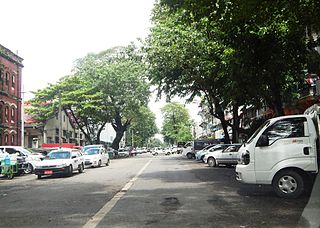
Bo Aung Kyaw Street or Road, formerly Sparks Street is a major street, passing south–north through Kyauktada Township and Botataung Township in southern Yangon, Burma. The street begins at an intersection near the Yangon River with Strand Road at 16°46′9″N96°9′51″E, passes north and crosses Maha Bandula Road and Anawrahta Road before eventually joining Bogyoke Aung San Road at 16°46′44″N96°9′52″E.

The Singu Min Bell, also known as the Maha Gandha Bell, is a large bell located at the Shwedagon Pagoda in Yangon, Myanmar (Burma). It was donated in 1779 by King Singu, the fourth king of Konbaung Dynasty. The official Pali name of the bell is Maha Gandha, which means "Great Sound".
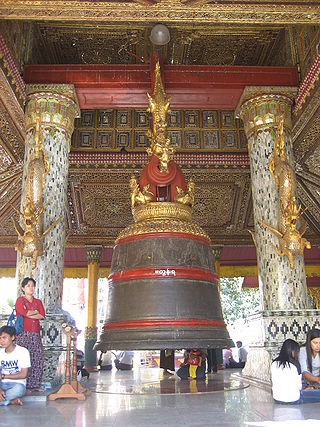
The Tharrawaddy Min Bell, also known as the Maha Tissada Gandha Bell, is a large bell located at the Shwedagon Pagoda in Yangon, Myanmar (Burma). It was donated in 1841 by King Tharrawaddy, of Konbaung Dynasty. The official Pali name of the bell is Maha Tissada Gandha, which means "Great Three-toned Sweet Sound".

The former High Court Building is a colonial-era building located at No. 89/133 Pansodan Street, between Maha Bandula Garden Street and Pansodan Street in Kyauktada Township, downtown Yangon.


















